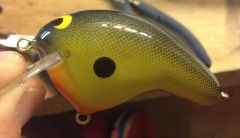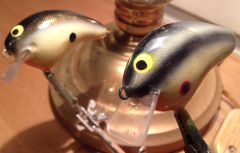-
Posts
43 -
Joined
-
Last visited
Content Type
Profiles
Articles
TU Classifieds
Glossary
Website Links
Forums
Gallery
Store
Everything posted by rufthumbs
-
Thanks Bob I appreciate you sharing.
-
Bob...do you know if there is a difference in weight between a black nickel & bronze hook? I bought some Vmc short shank BN#2's and was surprised that they were just as heavy as anything else I had on hand...i guess I thought the shorter shank would equate to being lighter.
-
does anyone know where to find the weight of different size treble hooks online? I can weigh and compare the hooks I have but it would be nice to know a hooks weight before buying them...I have emailed a couple "hook" folks and haven't received any information back... I appreciate any leads you may have..
-

Here Are My Questions. Can I Have Some Answers?
rufthumbs replied to xix coleman xix's topic in Hard Baits
I sometimes use glue on a balsa blank....I keep the fingers from the used latex gloves I use when using air brush to place over my finger to spread the glue when I use it...I just snip em off with scissors to re purpose them when using glue...I have also used walmart sacks laying around as well by just placing my who hand inside them like a puppet...the glue will run itself over the balsa with the help of gravity and if its thin glue like you want some will soak...give it a rub or two as you go then I nose hang them to dry using an "S" shaped piece of wire... I know its a no brainer...but dont breathe or let fumes in your eyes. -
-
Thanks for the input guys....I chose a location to measure the lip angle that I'm going to move forward with in attempt to "control" one of the many variables involved in achieving how I want it to swim(very similar to Daves 15% because i was able to make sure I'm "square" at another point in my layout) My line tie I've chosen a spot for as well also hoping to "control" another variable. Next on my list is choosing a ballast weight that I can consistently use for my harness as I begin to adjust its location to a desirable position. So far I've been drilling out various "mojo" & "egg" style weights with different diameters to use as a belly weight. This method of drilling is pretty inconsistent especially when you start cutting on them to obtain different amounts of weight. When I started experimenting with the "egg" style weights I began to wonder if belly weights were a complete cylinder shape as they continue into the plug or if the partly exposed cylinder looking weight changed from a cylinder shape to a different shape of sorts (i.e. Sphere)as they proceeded into the plug ....do y'all mostly use a cylinder shaped ballast weight(mojo style) or do y'all toy with changing its form as it enters the belly?
-
Ha! from jar head to flat head...lol I sat out her piddling for a few hours thinking that I just need to roll with my process then I saw your post Mark and it hit home that I just need to keep building and stop figuring...I sat here and thought every time I build one and test it I learn something new so I'm just gonna keep building. Lol
-
Thanks for the input and I understand what y'all are saying....I just didn't know if there was a given location for the angles vertex from which you measure a lips angle on a plug...for the longest time I kept trying to create some kind of relationship with where my harness dropped from the H center line and the angle of my bill....I couldn't quite figure out how the bill angle was measured because depending on where the vertex of the angle is on the H center it will change the measure of the angle of the bill... sort of what Vman indicated in the "15%" mark on the X axis that appeared to be a generalized location from which to measure.....my plan is to create my own location to measure my bill angle since there doesn appear to be a specific location on the H center line that is followed...I will prob review the few templates I've made to make the math a little easier and rethink those measurements some so I can use a standard location like 1/5 of the plugs length behind the pull point or something of that nature build that geometric relationship from there. The templates I've made are intended to build a round bodied squarebill plug similar to a Jim Bagley plug.
-
thanks for the ideas..... I am going to try them as I think your ideas will make a difference in what I do...I appreciate it a lot...sometimes a guy just needs a little kick in the rear to knock him forward a little when he gets a little stuck....To be honest I have no desire to reinvent the wheel nor am I on a quest to develop the something that has never been seen, but rather an understanding of a process that doesn't include a series of WAG's ...
-
I am curious because I just don't know better...where is the vertex of the lips angle located? In other words does everybody measure the angle of their lip from a "given" location?(i.e. the intersection of the Vertical & Horizontal Center Lines) Is this process of determining an accurate measurement part of an "individuals build formula" or is there a common way of measuring a lips angle which I am just overthinking and not understanding.... I have been trying various methods on how I measure my lip and ballast angle as I "find my way" to a geometric process that will build consistent plugs that swim and react the way I want them to...I understand math pretty descent but so far my eyes and ability to duplicate something similar to what I see has proven to be my biggest asset in building my plugs...I have refused to split open any of my "good plugs" that I have, to compare them to how I am building mine but I know I am getting closer to putting all the pieces together in understanding the geometry involved....I also understand that in time once I master the many processes of building a plug (Lordy I have done some dumb things that screw up a lot of invested time) there stands a good chance I will find enlightenment regarding this whole process that I am in relentless pursuit of... I know some of you may have been mentored by an old timer whose eyes can just produce the necessary geometry involved or heck some of you can probably even eyeball it yourself, but can one of you boys who know about the vertex of the lip angle share this with me if it isn't taboo to do so? Rest assured I wont be butt hurt if its something that must be learned on my own because I am beginning to understand the time invested in building a good handmade plug...I think being a little hard headed will help me as well in figuring it out too...LOL I dang sure wouldn't lay out all the knowledge I acquired through hard work and patience on a silver platter on public forum for some fella to come along and do nothing for...so in that regard I feel like I get it because the level of understanding I have acquired so far has come from reading, studying plugs(in and out of the water) for countless hours over the last few years and TOO many hours tinkering with a big batch of balsa a buddy gave me a couple years back... Ira
-
Hello my name is Ira and I've become addicted to figuring out how to make a good balsa plug. I am especially intrigued by the math and precision involved with making a plug swim "right". I recently acquired an airbrush so I'm finally able to make a plug from start to finish. These are the first two plugs that I suspect to be fish catchers. They were whittled with my pocket knife and sanded with some fine sandpaper.
© iRaC
-
After my previous reply I imediately cut it open because I wanted to see where/if water got inside...I could not tell where water got in and could only see where the glue soaked through. I've thought about it a lot since...I remember being extremely liberal with the epoxy when I put it on that specific plug thinking that I want it water tight...lol ...some of the others that I epoxy clear coated over paint in the same batch have some very isolated "squish" to them but it's nowhere near as pronounced as the bait of topic...and then some of the others are very stable and solid...I used different amounts of alcohol through out my epoxy adventure which I plan on correcting and not use so much the next time. So the next round of plugs I'm going to skip the glue and lightly seal then with epoxy after the halves are put back together before I swim it to see if the plug is worth painting or not I think I was just excited about putting them on the turner I had just made and thought the turner would make up for my lack of patience with trying to stretch the epoxy between too many baits. Bottom line...I'm a greenhorn when it comes to building a plug and I've got to get it through my thick head that patience and precision can't be sacrificed if you want the bait to be right. I appreciate all of the input and ideas...I will get it right because every go round I make new mistakes to learn from but many I have avoided just by lurking and reading posts from those who have gotten it right.
-
Thanks Dave...I will make sure I'm sealed better then before testing the bait. I appreciate te swift response.
-
I made a balsa crainkbait covered it with super glue to seal the wood before initial swim test...wood seemed fine(still hard from super glue) long after being in water(many months)....I then decided to apply bob smith 30 min epoxy and let rotate on turner for a few hours( I wanted to try painting on the epoxy as oppose to the supper glue hoping it wouldn't take 649 layers of a white createx base coat). This morning I decided to take a look and the top coat feels "squishy" on the sides of the bait when you pinch the bait...the epoxy has hardened but it seems like there is a layer of air captured between the epoxy and balsa wood...I'm really not sure what I did wrong....did water get through my super glue seal or did I have air bubbles in my epoxy that prevented it from adhering to the wood correctly? Was the problem temperature related as the epoxy set up? My gut tells me it has something to do with water getting in the plug somewhere but any help or pro tips would be greatly appreciated as I'd like to understand what I did wrong... Ira
-
I dont airbrush or paint yet, but I have seen the glass bottles utilized to hold the paint...if it were me I would start with some sort of "padded" hose clamp and I would probably "fabricate" the blade in some way that houses the paint bottle...the attachment part of the blade isn't so complex that a guy could probably build his own pretty easily...I think at the end of the day shaking by hand may be most the proficient way of doing this, but I don't have much experience with mixing paint and plus everybody has their own way of doing things...Personally, I would use the saw only if I knew it did something more effectively for my process of painting a bait...but thats just me.
-
Use your reciprocating saw ;-)
-
please share your source. ira





